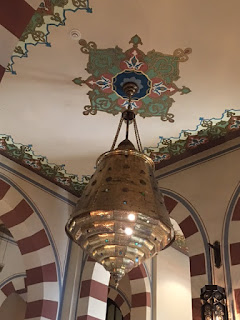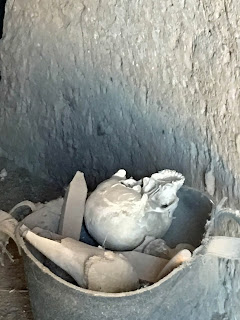With plans to hit the historic walled Coptic enclave, and on the advice of our hotel desk manager, we ventured out for our first subway ride. Conveniently located near our pensione, it dropped us off right in front of the Coptic Museum but not before learning a few lessons. First, you're supposed to insert your ticket into the turnstiles for both entering the system and on leaving. A family cluster of Hijab wearing women kept poking me in the back to alert me about that, pointing to my stub sticking out of the machine. Also, gentlemen do not enter ladies cars, as several men pointed out when we stood on the wrong part of the platform. Other than that we learned once again, that Egyptians are just such thoughtful caring folks. Turns out that the culture venerates their elders and people kept offering me a seat, senior citizen that I am. And to our delight, our stop fell exactly on the steps of the Roman towers and the garden entry to the Museum. Built by Trajan in the first century AD, the towers and wall of the enclave once abutted the Nile, protecting the district, which housed the early Christian community. Nearby courtyards and gardens framed the Coptic Museum. Built in 1908, this gorgeous carved ceiling modest sized museum houses a great collection of early Christian art showing the transition from the Ptolemaic to the early Islamic period of Egypt's history. Displays of stone and wood carvings, monastery murals and textile fragments, were augmented by books and manuscripts, including the oldest book of psalms. One room housed major source material of gnosticism, the Nag Hammadi manuscripts. Even more interesting for me was the gallery that clearly displayed the absorption of Greek, Roman, and Pharaonic imaging and mythology into early Christianity. Crosses incorporating the ancient ankh form were particularly striking, as were pre-Christian depictions of baptism and rebirth.
Beyond the museum and deeper into the walled enclave were a number of early churches including the 9th C Hanging Church so called because it straddles and hangs over the old Roman wall. This and other churches visited were filled with fabulous icons, each church varying in personality. Just outside the Roman wall was a 4th C church structure that became the 9th C Ben Ezra Synagogue. It was believed to be on the spot where Pharaohs daughter found Moses in the reeds of a spring and also where Mary fetched water to wash Jesus. The oldest Synagogue in the Cairo, its simple exterior belies the rich black and white marble interior. Alas, no photos allowed so with time short, we reluctantly retraced our steps through the compound. After the train back, we walked past shops we'd hoped to hit for the last time including a patisserie. The crowd queuing outside the patisserie suggested it was popular but inside, it was absolute bedlam. People were just jammed themselves into the two room shop and you had to go with the flow or else with browsing not an option so, I joined the fray. Grabbing boxed sweets off the shelves, I spied a counter with pan au chocolat and had a couple bagged for the early morning drive to the airport, then surged toward the checkout before literally being ejected out onto the sidewalk. Phew! Asked a fellow if there was some holiday people were frantically buying for and he said no, it's normal activity, Cairienes just love their sweets. Well, call me crazy, but I just love Cairo!
For our last dinner in Cairo, we decided to head back to the sleepy but iconic Windsor, with its trophies and sad Christmas tree but also, celebrated martinis and the best hummus and other nibbles. At the front desk with its ancient telephone switchboard and letter slots, we took what is described as Cairo's oldest elevator up to explore what rooms there are like. An anti chamber with two mother of pearl sideboards on the walls leads to the rooms themselves, large and comfy. Who knows what next December brings but looking at these rooms, it's easy to dream and imagine coming back because for all the wonderful experiences we've had, we've only just scratched the surface.
Beyond the museum and deeper into the walled enclave were a number of early churches including the 9th C Hanging Church so called because it straddles and hangs over the old Roman wall. This and other churches visited were filled with fabulous icons, each church varying in personality. Just outside the Roman wall was a 4th C church structure that became the 9th C Ben Ezra Synagogue. It was believed to be on the spot where Pharaohs daughter found Moses in the reeds of a spring and also where Mary fetched water to wash Jesus. The oldest Synagogue in the Cairo, its simple exterior belies the rich black and white marble interior. Alas, no photos allowed so with time short, we reluctantly retraced our steps through the compound. After the train back, we walked past shops we'd hoped to hit for the last time including a patisserie. The crowd queuing outside the patisserie suggested it was popular but inside, it was absolute bedlam. People were just jammed themselves into the two room shop and you had to go with the flow or else with browsing not an option so, I joined the fray. Grabbing boxed sweets off the shelves, I spied a counter with pan au chocolat and had a couple bagged for the early morning drive to the airport, then surged toward the checkout before literally being ejected out onto the sidewalk. Phew! Asked a fellow if there was some holiday people were frantically buying for and he said no, it's normal activity, Cairienes just love their sweets. Well, call me crazy, but I just love Cairo!
For our last dinner in Cairo, we decided to head back to the sleepy but iconic Windsor, with its trophies and sad Christmas tree but also, celebrated martinis and the best hummus and other nibbles. At the front desk with its ancient telephone switchboard and letter slots, we took what is described as Cairo's oldest elevator up to explore what rooms there are like. An anti chamber with two mother of pearl sideboards on the walls leads to the rooms themselves, large and comfy. Who knows what next December brings but looking at these rooms, it's easy to dream and imagine coming back because for all the wonderful experiences we've had, we've only just scratched the surface.





































